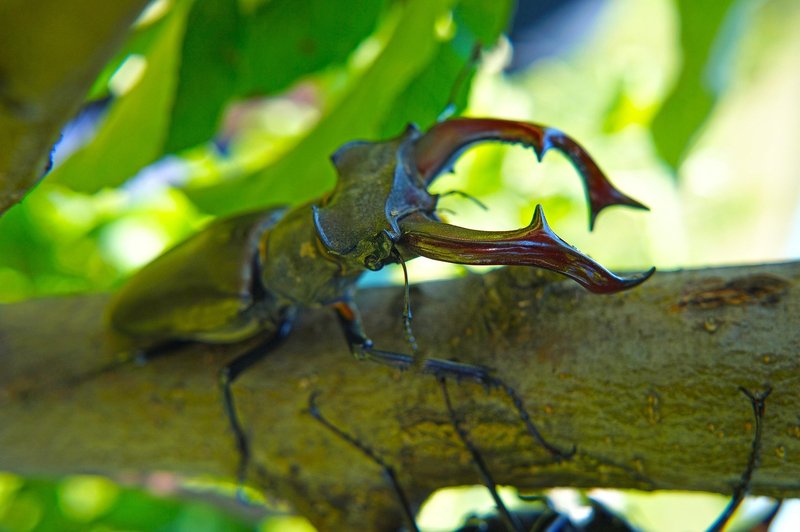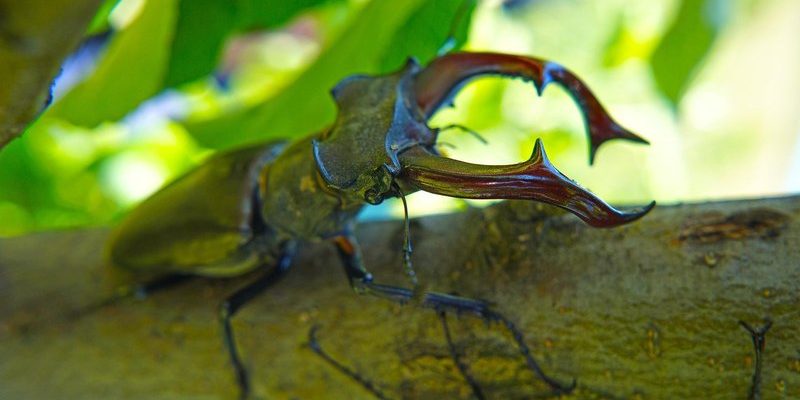
Stag beetles belong to the Lucanidae family, and they are prominent in temperate forests across Europe, Asia, and North America. Their habitats vary widely, from lush woodlands to sunny parks. What’s even more interesting is how they adapt to their surroundings, ensuring their survival and success. Just like a chameleon blending into its environment, stag beetles have some cool tricks up their sleeves. Buckle up, and let’s explore the world of stag beetles!
Natural Habitat of Stag Beetles
Stag beetles are typically found in wooded areas. They prefer places with plenty of trees where they can burrow into the bark or live in decaying wood. This preference is crucial because their larvae feed on rotting wood, making these habitats a buffet for them! You might see them in parks, gardens, or even your backyard if there’s enough greenery.
However, stag beetles are not limited to just forests. They can also thrive in urban areas. As long as there are suitable trees and decomposing wood, they’ll set up shop. This adaptability means you might spot one in a city park or even in a flower garden.
Let’s not forget about the seasonal changes. In winter, stag beetles dig into the ground or hide in tree bark to hibernate. When spring arrives, they emerge to mate and continue their lifecycle. Nature has a fascinating way of ensuring their survival through these adaptations.
How Stag Beetles Adapt to Their Environment
Adaptation is the name of the game for stag beetles. Their physical features play a significant role in how they survive. For instance, the males boast those impressive pincers, which they use to compete for mates. One might say they’re showing off their best features, much like us humans do!
But it’s not just looks; their pincers also serve as tools. When it comes to defending themselves against predators, they can put up quite a fight. In a way, their pincers are a form of armor, providing protection as they navigate their habitat.
Stag beetles also exhibit behavioral adaptations. For example, during dry seasons, they might become more active at night, escaping the heat of the day. This shift helps them find food and mates while avoiding the risk of dehydration. It’s a smart move, allowing them to make the most of their environment.
The Role of Decaying Wood in Their Life Cycle
Decaying wood is the lifeblood of stag beetles. Not only do the adults rely on the nutrients found in rotting wood, but their larvae do too! After mating, female beetles lay eggs in the soft, decaying wood. Once the larvae hatch, they begin to munch on this nutrient-rich food source, which helps them grow.
This relationship with decaying wood isn’t just about survival; it’s also essential for the ecosystem. As the larvae feed on wood, they help decompose it, returning nutrients to the soil. This process supports the health of the forest or park they inhabit. You could say stag beetles are unsung heroes of the environment!
Moreover, their presence indicates a healthy habitat. If you’re spotting stag beetles in your area, it means the local ecosystem is thriving. They act as a reminder of the interconnectedness of life and the importance of preserving natural spaces.
Stag Beetle Conservation Status
Unfortunately, stag beetles face threats, mainly due to habitat loss. Urbanization and deforestation are significant issues, reducing their living spaces. Some species have even become endangered. The loss of old trees, which are vital for their lifecycle, is especially concerning.
Efforts to conserve stag beetles include protecting woodland areas and promoting awareness about their role in the ecosystem. Many organizations focus on creating suitable habitats by planting native trees and maintaining existing forests.
Community involvement is also crucial. Simple actions like preserving old trees in your backyard or supporting local conservation efforts can have a significant impact. This way, we contribute to a healthier environment for stag beetles and countless other species.
Interesting Facts About Stag Beetles
Stag beetles are full of surprises! Here are some intriguing facts that might just fascinate you:
- Size and Color: Stag beetles vary in size, with some species measuring up to 4 inches long. They often have striking colors, from brown to black.
- Life Span: These beetles can live up to three years, but their adult lives are relatively short, lasting only about a few months.
- Sound Communication: Males may produce sounds during courtship, using their pincers to create vibrations. It’s like a tiny love song!
- Collecting Enthusiasts: Stag beetles are popular among collectors, and some species can be quite valuable.
These facts make stag beetles not just fascinating but also a topic of interest for scientists and nature lovers alike.
How to Attract Stag Beetles to Your Garden
If you want to invite stag beetles into your garden, there are several steps you can take. Start by creating a diverse habitat. Plant native trees and shrubs that provide food and shelter. *Decaying wood or log piles* are also great additions; they mimic their natural habitat and offer a place for larvae to grow.
Consider avoiding pesticides, as these chemicals can harm stag beetles and other beneficial insects. Instead, opt for natural pest control methods. Creating a balance in your garden ecosystem will make it a welcoming space for stag beetles.
Lastly, if you spot one, resist the urge to disturb it. These beetles are often just passing through, and your garden can become a temporary haven for them.
Stag beetles are more than just striking insects with impressive pincers; they are a vital part of our ecosystems. Their ability to adapt to various environments—from lush forests to urban parks—shows just how resilient they are. By understanding where they live and how they thrive, we can appreciate their role in nature a little more.
So next time you see a stag beetle, take a moment to admire its beauty and remember the important role it plays. By protecting their habitats and promoting conservation, we help ensure these fascinating creatures continue to thrive for generations to come.

